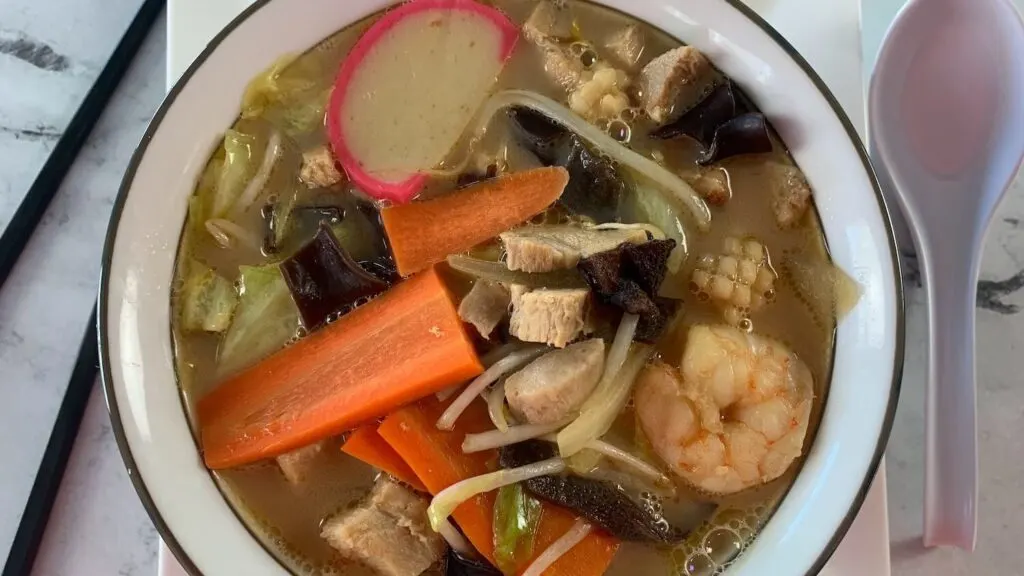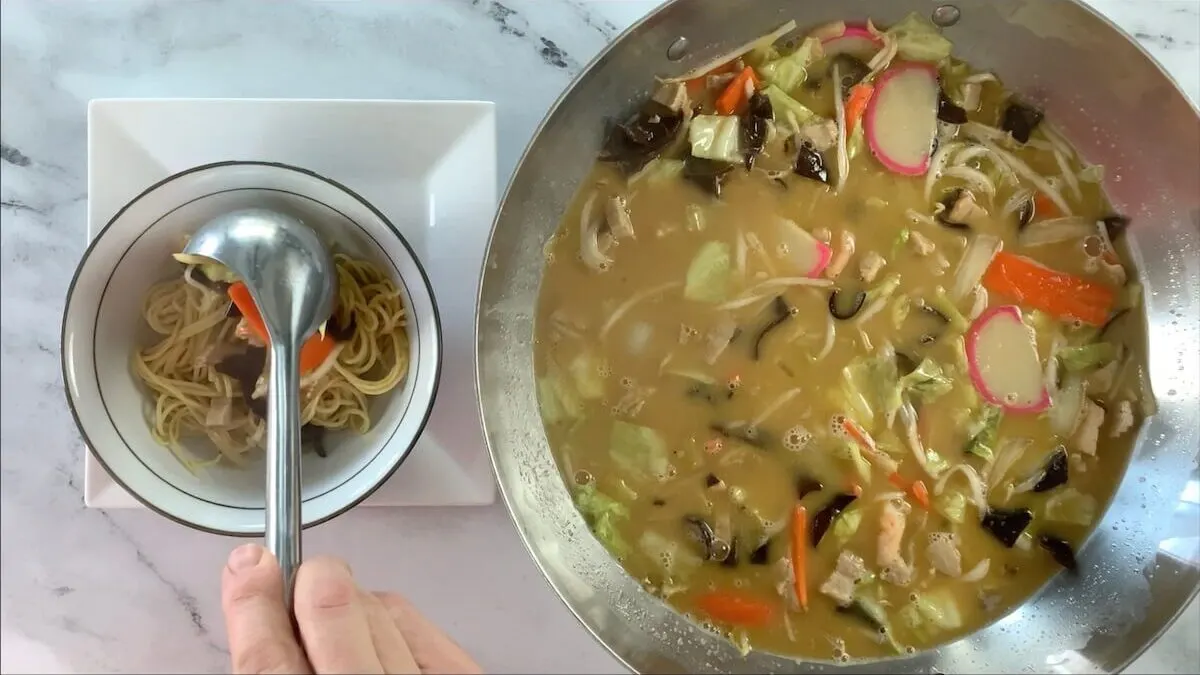
Champon is a noodle soup with loads of toppings that include veggies, seafood, and pork belly. The pork and seafood give champon a hearty seafood flavor that’s hard to beat. This is a great meal to enjoy on a chilly day!

Table of Contents
What is Champon?

Introduced to Japan in the mid 20th century, champon is most popular in the southern city of Nagasaki, Japan. However, while considered a regional dish to Nagasaki, it’s enjoyed throughout Japan and in some specialty restaurants around the world.
The ingredients can vary depending on the ingredients you may have on hand or the preferences of the chef preparing it. However, champon will almost always include chashu pork (Japanese braised pork belly), seafood, veggies, and champon noodles. Although a little thinner than champon noodles, ramen noodles are a good substitute if you can’t find champon noodles in your local Japanese grocery store.
Nagasaki champon is a hearty soup with lots of toppings that can definitely be eaten as a main course.
How to Make Nagasaki Champon
Traditionally, champon broth has a pork stock base. However, I prefer to use a combination of chicken stock and dashi as I think these flavors complement the seafood used in the toppings, giving the whole soup a strong seafood flavor with a savory hint of pork brought out by the chashu.
Also, when I make champon, I start with cooked chashu slices that I would use in ramen. I then cut the chashu into bite-sized pieces prior to adding to the soup as I think the cooked chashu adds more of a savory flavor to the broth.
When making Nagasaki champon, I use the following ingredients:
Soup Broth
- 4 Cups Chicken Stock/broth
- 2 Cups Dashi
- 1/4 Cup Soy Sauce
- 2 Tbsp. Mirin
- 2 Tbsp. Sugar
- 1 Tbsp. Oyster sauce
- 1 tsp Salt
- 1/2 tsp White pepper
- 1/4 Cup Heavy whipping cream
Soup Toppings
- 2 Tbsp. Sesame oil
- 1 Tbsp. Soy sauce
- 1 lb. Chashu Pork (4 slices)
- 8 Large shrimp
- 4 oz. Squid
- 12 Pieces Dried wood ear mushroom Rehydrated and diced
- 2 Carrots Peeled and sliced into rectangle strips
- 1/2 Onion Sliced
- 4 Leaves Cabbage
- 8 Slices Kamaboko (fish cake)
- 8 oz. Bean sprouts
- 12 oz. Champon noodles
Below are step by step instructions on how to make a hearty Nagasaki champon.
Rehydrate Mushrooms and Prepare Broth
1. Rehydrate the mushrooms by soaking them in cold water for 20-30 minutes.
2. Pour the broth ingredients (except for the cream) into a pot and bring to a boil on medium heat. Stir frequently until sugar is dissolved.

3. Once boiling, reduce heat to a simmer. I usually move the pot to the back burner on simmer to keep it hot and out of the way.
Prepare Champon
1. Bring a separate pot of water to a boil for the noodles.
2. Prepare ingredients by cutting cashu into bite-sized pieces, cutting the carrot into thin rectangle slices, cutting the cabbage into small squares, cutt the squid into bite-size pieces, slicing the onion, and cutting the mushrooms into slices (if necessary).

3. After all the toppings are prepared, cook the champon noodles in the boiling water for around 3 minutes.

4. Once noodles are done cooking, strain thoroughly making sure to get rid of as much water from the noodles as possible. This is important as extra water can dilute the broth. Once strained, add an individual portion of noodles to your soup bowl.

Cook Toppings and Finish Champon
1. Heat sesame oil in a wok or large skillet on medium-high heat. If you are using uncooked pork belly, add to skillet now and cook until seared on the outside (1-2 minutes). I like to use cooked chashu as I think that brings a deeper flavor to the broth so I usually add the cooked chashu with the rest of the seafood.

2. Add cooked chashu pork (if previously cooked), squid, shrimp, onion, and 1 Tbsp. of soy sauce to the wok and cook until the shrimp and squid are cooked.

3. Next, add the carrots and cook for one minute, stirring frequently.

4. Add mushrooms, cabbage, and kamaboko and cook for one minute, stirring frequently.

5. Then, add the bean sprouts and cook for an additional minute, stirring the mixture frequently.

6. Pour the simmering broth into the meat and vegetable mixture and stir to combine. Lower heat to simmer and add the cream to the champon.

7. Add roughly 1/6 of the soup toppings and broth to the noodle bowl.

8. Serve and enjoy!
Nagasaki Champon Recipe

Authentic Nagasaki Champon
Equipment
- 1 Wok (or large skillet)
- 1 Pot for broth
- 1 Pot for cooking noodles
- 1 Sharp knife
Ingredients
Broth
- 4 Cups Chicken Stock/broth
- 2 Cups Dashi
- 1/4 Cup Soy Sauce
- 2 Tbsp. Mirin
- 2 Tbsp. Sugar
- 1 Tbsp. Oyster sauce
- 1 tsp Salt
- 1/2 tsp White pepper
- 1/4 Cup Heavy whipping cream
Soup Toppings
- 2 Tbsp. Sesame oil
- 1 Tbsp. Soy sauce
- 1 lb. Chashu Pork (4 slices)
- 8 Large shrimp
- 4 oz. Squid
- 12 Pieces Dried wood ear mushroom Rehydrated and diced
- 2 Carrots Peeled and sliced into rectangle strips
- 1/2 Onion Sliced
- 4 Leaves Cabbage
- 8 Slices Kamaboko (fish cake)
- 8 oz. Bean sprouts
- 12 oz. Champon noodles
Instructions
- Rehydrate the mushrooms by soaking them in cold water for 20-30 minutes.
Prepare the Broth
- Pour the broth ingredients (except for the cream) into a pot and bring to a boil on medium heat. Stir frequently until sugar is dissolved.
- Once boiling, reduce heat to a simmer. I usually move the pot to the back burner on simmer to keep it hot and out of the way.
Prepare Champon
- Bring a separate pot of water to a boil for the noodles.
- Prepare ingredients by cutting cashu into bite-sized pieces, cutting the carrot into thin rectangle slices, cutting the cabbage into small squares, cutt the squid into bite-size pieces, slicing the onion, and cutting the mushrooms into slices (if necessary).
- After all the toppings are prepared, cook the champon noodles in the boiling water for around 3 minutes.
- Once noodles are done cooking, strain thoroughly making sure to get rid of as much water from the noodles as possible. This is important as extra water can dilute the broth. Once strained, add an individual portion of noodles to your soup bowl.
Cook Toppings and Finish Champon
- Heat sesame oil in a wok or large skillet on medium-high heat. If you are using uncooked pork belly, add to skillet now and cook until seared on the outside (1-2 minutes). I like to use cooked chashu as I think that brings a deeper flavor to the broth so I usually add the cooked chashu with the rest of the seafood.
- Add cooked chashu pork (if previously cooked), squid, shrimp, onion, and 1 Tbsp. of soy sauce to the wok and cook until shrimp and squid are cooked.
- Next, add carrots and cook for one minute, stirring frequently.
- Add mushrooms, cabbage, and kamaboko and cook for one minute, stirring frequently.
- Then, add bean sprouts and cook for an additional minute, stirring the mixture frequently.
- Pour the simmering broth into the meat and vegetable mixture and stir to combine. Lower heat to simmer and add the cream to the champon.
- Add roughly 1/6 of the soup toppings and broth to the noodle bowl.
- Serve and enjoy!
Video
Nutrition
Frequently Asked Questions
Is champon gluten-free?
Unless you make it yourself using gluten-free ingredients, I would not count on Nagasaki champon being gluten-free as it contains noodles and soy sauce. However, this would be easy to make gluten-free by using gluten-free versions of the noodles and soy sauce.
Is champon a type of ramen?
While it’s very similar to ramen, champon is not considered ramen as it uses champon noodles, which are slightly thicker than ramen noodles. The toppings are sometimes different or are presented differently in champon. For example, ramen eggs are not typically found in champon. Chashu is typically presented in ramen in large slices whereas in champon it’s cut into bite sized pieces. Champon often also has more toppings than ramen making it a heartier soup.
What is a good substitute for champon noodles?
Although not quite as thick as champon noodles, ramen noodles make for a great substitute for champon noodles.
Final Thoughts on Nagasaki Champon
If you are looking for a hearty comfort soup with a savory seafood flavor, champon is a great option. I hope that you enjoy this recipe as much as I do! Happy cooking!
For more great videos subscribe to our YouTube Channel.
Check out below for more great articles:
